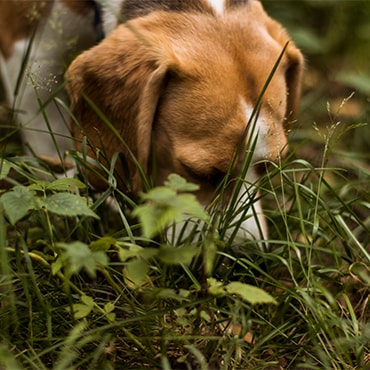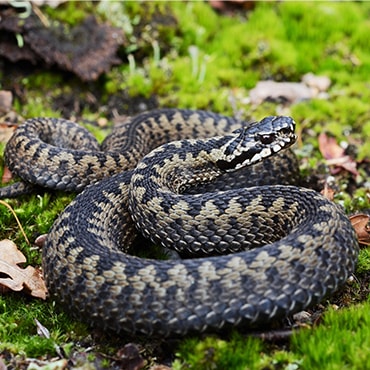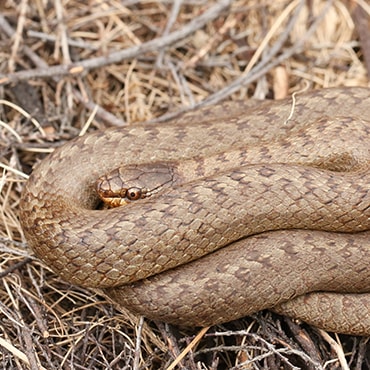
Adder bites in dogs
Overview
- Snake bites are an emergency – if your dog has been bitten, follow our first aid advice and let us know ASAP. We will prioritise an adder bite as this is an emergency.
- There are three types of snake found in the UK, but adders are the only venomous species.
- Adder bites tend to happen Feb-Oct but are especially common between Jun-Aug.
- It’s most common for a dog to be bitten on the face, neck or lower leg.
- With treatment, most dogs recover from adder bites, but some bites are very serious, cause severe illness and even death.
General information
There are three types of snake in the UK: grass snakes, smooth snakes and adders. The adder is the only venomous species, grass snakes and smooth snakes aren’t venomous and don’t tend to bite.
Adders tend to keep themselves to themselves and don’t bite unless they are scared, unfortunately, dogs tend to approach them without fear, startle them and get bitten.
If your dog has bitten by an adder, their symptoms will depend on where the bite is, and where the venom spreads to. If the venom stays in the tissues around the bite, it will cause pain and swelling, but if it spreads further and gets into the bloodstream, it can cause much more serious problems such as damage to the liver, kidneys, heart and nervous system. If venom is injected straight into the blood stream, it can cause death very quickly. It can also be very serious if your dog is bitten on the face or neck because swelling can lead to breathing problems.
With treatment, most dogs make a full recovery, but sadly, in some cases, adder venom can cause severe illness and even death. The quicker your dog is treated, the better their outlook. Any dog with a suspected adder bite should be seen by a vet ASAP.

First aid for a snake bite
- Stay calm
- If you see the snake, try to remember what it looks like, or take a photo from a distance. Do not try to find the snake, get close to it, touch it or harm it. (Adders are a protected species so it is illegal to hurt or kill them, and they can bite people if disturbed.)
- Keep your dog as still as possible to prevent venom spreading around their body
- Leave the bite alone, don’t apply a bandage or tourniquet.
- Call you vet to let them know you are coming down to the practice
- If possible, bring a car to your dog or depending on their weight, carry them to it.
What do adders look like?
Adders are easy to identify (see image below), they are small, grey/brown snakes with a distinctive V-shaped marking on their head and dark zigzag pattern down their back.
They are most common in long grass, woodland, moorland and by the coast (sand dunes/coastal paths). They are active Feb-Oct and hibernate during the winter.

The adder is a small, chunky snake with an obvious zig-zag pattern down its back and a V-shape marking on its head.

The grass snake is a green/brown snake with yellow and black markings behind its head and dark patterning down it’s sides.

The smooth snake is very rare, looks similar to an adder but it slimmer and doesn’t have the obvious zigzag pattern down its back. Smooth snakes vary from being grey to dark brown.
Symptoms of an adder bite
Adder bite symptoms can take anywhere between couple of minutes to an hour to develop. They tend to be worse in dogs that are bitten on the face or neck, and much worse if the venom makes its way into the blood stream.
Mild symptoms:
- Pain and swelling around the bite
- Limping (if bitten on a leg)
- A few tiny bite marks
Serious symptoms:
- Vomiting and diarrhoea
- Pale gums
- Panting
- Drooling
Very severe and potentially life threatening symptoms:
- Weakness and wobbling
- Swelling to the face or neck
- Severe bruising and abnormal bleeding
- Tremors and seizures
- Difficulty breathing
- Collapse
- Sudden death can occur if adder venom is injected straight into the blood stream
Treatment
If your dog has been bitten by a snake, it’s important they are seen by a vet ASAP, don’t attempt to treat them at home. Treatment will depend on the symptoms they develop, but as a start, is likely to involve:
- Strong pain relief
- Careful monitoring – your vet will monitor your dog closely and keep an eye out for complications such as kidney failure, heart problems and bleeding problems. It’s likely that your dog will need to stay in for monitoring and investigations (such as ECG’s and blood tests) for at least 24 hours unless they only have very mild symptoms.
- A fluid drip – to support their internal organs (such as the liver, kidneys and heart), and help them if they have gone into shock.
- Antihistamines – to help reduce swelling and further symptoms developing.
In more serious cases, your dog might require:
- Anti-venom – anti-venom is sometimes necessary in more severe cases, however, there is a small risk of a drug reaction when using anti-venom, and it can be difficult to get hold of, however we have good stock levels and are the only vet in the Tyne Valley to stock Anti-venom.
- Antibiotics – only necessary if your dog develops an infection around their bite wound
- Surgery – some dogs develop necrosis (tissue death) around the bite wound. If your dog develops necrosis, they may need an operation to remove the dead tissue.
Prevention
There are few steps you can take to help prevent your dog being bitten by an adder:
- Avoid areas well known for adders in the summer months (especially June-Aug) or when in those areas, keep your dog on a path and on a lead.
- If you are holiday somewhere you aren’t familiar with, do some research to find out if there are any adder ‘hot-spots’ before walking your dog.
- Remember, adders are most commonly found in long grass, woodland, moorland, and along the coast (sand dunes/coastal paths).
